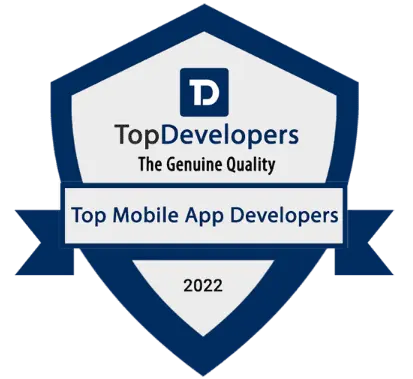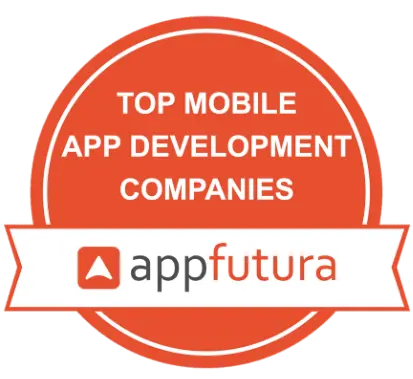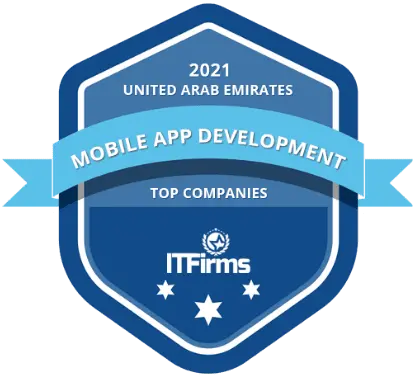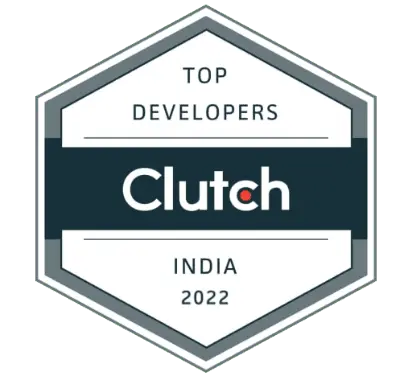Have you ever thought about how apps like Bigo Live attract millions of users who watch live videos and stream live content each day? Live streaming is not just for fun anymore -it’s a multi-billion dollar industry. The global live-streaming market will surpass $247 billion by 2027 as the United States provides over $70 billion in annual revenue to live streaming.
You may be an entrepreneur or tech visionary trying to seize this opportunity and are curious about how to build a Bigo Live live streaming app. Whether your purpose is to create a live streaming app for influencers, gamers, educators, or brands, knowing the Video Streaming app development process, the cost to develop the video streaming app, and some of the important features is key.
In this in-depth guide, we will cover everything to get you started, from market knowledge to development steps, cost to develop a live streaming app like Bigo Live, features to have, and tech stack. In the end, you will have a concrete plan to build a live streaming app like Bigo Live, which will compete with all the best video streaming apps in 2025 and beyond.
What is Bigo Live? – Market Stats
Picture an app that enables people in over 150 countries to live-stream, chat, make money, and develop communities: all happening simultaneously. That is Bigo Live. Bigo Live is not just another live-streaming app; it combines social interaction, monetization, and entertainment in one application.
Origins & What Bigo Live Does
- Founded in Singapore in 2014 by David Li and Jason Hu, the app was later launched in 2016 for both Android and iOS.
- The app is owned by BIGO Technology (which is part of JOYY Inc.), the company is focused on live-streaming slightly varied content: musicians, games, travellers, showcases of talent, social chats, and so on. Bigo Live includes features such as virtual gifts, 3D avatars, private video calls, and live-chat rooms with multiple guests.
User Base & Reach
- More than 400 million users are registered across the globe.
- Available in over 150 countries.
- From a usage perspective, in the fourth quarter of 2023, Bigo Live had approximately 38 million active users, with around 1.67 million users paying to use it.
Market Position & Growth
- Bigo Live is within the global live-streaming platforms space, and the company has moved up the ranking slowly but steadily. As of the middle of 2024, Bigo Live ranked as the 7th most liked live-streaming platform in the world by the number of hours people watched.
- Bigo Live has either outpaced or was very close to outpacing (in hours watched or purchased tickets) platforms like Facebook Live and Steam.
- The app has continuously expanded its revenue streams via in-app purchases, virtual gifts, advertisements, and creators’ programs. This helps maintain growth and supports monetization for both the platform and streamers.
US-Specific Metrics
- Bigo Live has retention rates of approximately 30-31% on Day 2 (D2) in the US, which is considered a very strong retention rate in the live streaming / social media category.
- It consistently ranks in the top 20 free apps in the US (especially on iPad) during multiple time frames.
Challenges & Unique Learnings
- While global reach is massive, user engagement and retention can vary greatly by region based on cultural differences, content preferences, and competition. Regionalizing content + community management has been a consistent theme for localization.
- Bigo Live employs technology around AI / ML and real-time communications to personalize user experience (by suggesting content, filters, avatars, etc), which preserves its relevance value.
How to Develop an App Like Bigo Live?
Creating a live streaming platform goes beyond writing code. The goal is to create a video, interaction, and revenue-generating ecosystem. A realistic, step-by-step timeline for creating a live streaming app similar to Bigo Live is provided below, along with useful feature overviews and a succinct case study.
1. Research & Define the Niche
Start with your intended audience, and then what content you want to focus on: are you targeting gaming, music, lifestyle, or multi-category like Bigo Live? In general, the less broad your niche is at launch, the fewer costs you will incur and the faster you will get to market.
Pro Tip: Research rivals like Twitch, YouTube Live, and Facebook Live to identify any holes that your app can address in a unique way, such as interactive educational sessions or localized content.
2. Feature Planning & Monetization Strategy
Design your feature roadmap, which will include core functions such as real-time broadcasting, live chat, gifting, and subscriptions. Choose between in-app purchases, advertisements, pay-per-view, or premium subscriptions as your revenue source.
3. Choosing the Appropriate Technology Stack
The technology stack you will use will affect the scalability and user experience. Common technology choices for each layer include:
- Frontend: React Native or Flutter for cross-platform development
- Backend: Node.js or Django with WebRTC for real-time communication
- Database: PostgreSQL or MongoDB
- Cloud & Streaming: AWS MediaLive, Wowza, or Agora for low-latency video delivery
- CDN: Cloudflare or Akamai for global traffic
Pro Tip: If you want to add features quickly or anticipate millions of simultaneous users, you should use a microservices architecture.
4. UI/UX Design
A clean and easy-to-use interface will drive repeat usage. Aim for a minimal click experience to get started streaming, video feeds that have high contrast, and a responsive framework for mobile screens. Include real-time engagement tools, like emoji reactions and live polls.
5. Development & Integration
- MVP Stage: Develop a minimal viable product to enable the most essential live streaming functionalities and conduct a speedy market test.
- API Integration: Integrating APIs that manage chat, payments, and push notifications will allow you to proceed more swiftly if the goal is to save time without creating new features and services.
- Security: Security is important, and you must maintain end-to-end encryption and GDPR compliance (and CCPA for U.S. users).
6. Quality Assurance & Testing
Test for video latency and stress in high-traffic situations. Testing needs to work on both iOS and Android devices.
7. Launch & Ongoing Updates
Launch marketing campaigns, gather user feedback, and deploy in-app marketplaces. To keep users engaged after launch, add new filters, gamification elements, or localized content regularly.
Read Also:
How Much Does it Cost to Develop an App Like HBO Max?
How to Develop a Social Media App Like Clubhouse?
Cost to Develop an App Like Bigo Live
The cost to create a live streaming app similar to Bigo Live, just like any software development project, can vary based on several factors, such as the geographical location of your developers, the complexity of the app’s features, the technology stack used, and so on. However, we can provide you with a guideline of costs and the main components of what you can expect to pay.
Average Development Cost
- A basic MVP (minimum viable product) can cost you between $60,000 – $90,000. This will build out those essential features, such as one-to-many live streaming, user registration, basic chat functionality, and integrate the appropriate payment services.
- A full-featured app (a Bigo Live clone app) can cost from $120,000 – $250,000+ and will provide you with all the bells and whistles like multi-guest streaming, AR filters, virtual gifting, AI moderation, and enhanced analytics.
Note: On a per-hour cost, companies in the USA charge on average $80 – $150 per hour, while Eastern Europe or India usually charge from $30 – $60 an hour.
Estimated Cost Breakdown (U.S. Market)
| Development Stage | Approx. Hours | U.S. Rate ($80–$150/hr) | Estimated Cost (USD) |
|---|---|---|---|
| Research & Planning | 80 – 100 | 80 – 150 | 6,400 – 15,000 |
| UI/UX Design | 120 – 160 | 80 – 150 | 9,600 – 24,000 |
| Frontend & Backend Development | 800 – 1000 | 80 – 150 | 64,000 – 150,000 |
| Video Streaming Integration (WebRTC/CDN) | 150 – 200 | 80 – 150 | 12,000 – 30,000 |
| Security & Compliance (GDPR/CCPA) | 60 – 80 | 80 – 150 | 48,00 – 12,000 |
| Testing & Quality Assurance | 120 – 160 | 80 – 150 | 96,00 – 24,000 |
| Deployment & Maintenance (Year 1) | Ongoing | 80 – 150 | 10.000 – 30,000 |
Pro Tip: Start with a lean MVP to test audience response before investing in advanced features like AI-driven recommendations or AR effects.
Additional Budget Considerations
Next, consider these additional costs once you build your app:
- Cloud Infrastructure: Streaming apps consume significant bandwidth. Monthly invoices for services hosted on AWS, Agora or similar services can range from $2,000 – $8,000, depending on your user traffic.
- Licensing and compliance: Your MVP may not need any; however, if you are creating a full-featured app, you should budget for additional legal costs for U.S. data privacy and copyright law that can run you another $5,000 – $10,000 via a reputable lawyer.
- Marketing & User Acquisitions: In your initial contribution, you should budget an additional $20,000 – $50,000 for your initial campaigns (partnerships with influencers, advertising on App Store for App installs, etc).
Real World Case Study
A media startup in the US built its MVP for $70,000, targeting local musicians on a video streaming platform. They made it scalable to 200,000 users by the end of year one. They attributed their retention rates of over 40% to their early investment in a reliable CDN, the correct AWS tools, and 24/7 tech support, which minimised downtime of the platform.
Factors that Affect the Cost of an App Like Bigo Live
Even for well-thought-out budgets, the end cost of developing a live streaming app, such as Bigo Live, can range considerably. The cost drivers can help you to prioritize needs vs wants and avoid overruns that you didn’t expect.
1. Complexity & Features of the App
The number of features and how complicated they are will matter the most.
- Basic Features: User profiles, one-to-many streaming, chat functionality, and push notifications.
- Advanced Features: Multi-guest streaming, AI-powered moderation, AR/VR filters and gamification capabilities.
Pro Tip: Start with an MVP, and then add complexity features after the launch based on users ‘ feedback, saving you up front.
2. Choice of Platform
The choice of platform, iOS, Android, or cross-platform, will have an impact on the time to develop.
- Native Apps (iOS + Android): Keep in mind that this will cost more, as a higher level of systems integration will be required.
- Cross-Platform (React Native/Flutter, etc.) – saves the cost of 25-30% as globally it can share a codebase.
3. Team Location & Hourly Rates
The developer’s hourly rate will differ based on the size of the country;
- United States: $80 – $150 per hour
- Europe: $40 – $90 per hour
- India/Asia: $25 – $60 per hour
Using a hybrid model in the US with project management and using an offshore developer team can help create a balance of quality and cost.
4. Real-time Streaming Infrastructure
Developing a reliable video streaming platform will mean you need dedicated servers and CDNs.
The high HD quality video will require a service provider with low latency. AWS Media Live, Agora, or Wowza video infrastructure, and availability can have a monthly fee of $2000 – $8000 per month, depending on scale.
5. Security & Compliance
Additional legal documentation and encryption are important with U.S. privacy laws (GDPR/CCPA/DMCA)
Expect an additional 5K to 10K for legal consulting and implementations.
6. Third-Party Integrations
While third-party integrations such as chat APIs, payment gateways, and analytics can save you time in development, they often require licensing or subscription fees.
7. Scalability & Maintenance
Your app will need to manage peak load (load of users) at the time of a live event.
You should estimate that the cost of scaling your servers, in addition to your ongoing maintenance cost, will be around 15-20% of your overall budget annually.
Example Scenario:
A startup in the U.S. budgeted $100,000 to develop a Bigo Live clone app with minimal features. Six months after launch, its user base reached three times the original amount, so they increased their cloud server and added AI moderation. As a result, their entire spend reached $160,000. If they had forecasted for scaling ahead of time, they could have avoided unnecessary cost and downtime.
Pro Tip: Always plan to allocate at least 20% of your budget for scaling and updating your app after launch to avoid surprise additional costs when your user base increases.
Features to Develop an App Like Bigo Live
To create a competitive Bigo Live clone app, you will need to have a set of features that can provide high-quality live video streaming, continuity of interaction, and monetization. Below are highlights of some must-have features in three areas of the user experience, creator tools, and admin actions, with some suggested modes of operating:
1. User-Facing features
Simple Registration and Profiles: Users should be able to sign up via email, phone, or social, and also have the ability to customize their profiles.
Pro Tip: One-tap social logins (Google, Apple, Facebook) will help improve conversions for sign-ups.
- High-Definition Live Streaming: Low-latency HD streaming with adaptive bitrate for different network speeds.
- Interactive Chat and Reactions: Users will have real-time comments in chat, as well as emoji reactions and “live polls.” These keep users engaged.
- Virtual Gifts and App Currency: Users can buy coins or tokens to send GIFTs. This is a key monetization feature.
- Push Notifications: Alerts when a preferred streamer goes live, and reminders when special events start.
- AI Recommendations: AI-driven recommendations will produce personalized stream suggestions to keep users watching longer.
- Content Discovery and Search: Trending streams, in-app category filters (think: gaming, music, lifestyle), and hashtags for search.
- Multi-Guest/Round Rooms: Allows for more than one streamer to co-stream together- this is essential for the social aspect of Bigo Live.
- Recording: Ability for users to record their streams and broadcast them later, therefore increasing the “lifecycle” of content.
2. Creator & Broadcaster Tools
- One-Click Streaming: Streamers have live streaming at their fingertips with built-in camera and microphone controls.
- Advanced Filters & AR Effects: Face Filters, background replacement, and stickers make the stream visually exciting.
- Monetization Dashboard: Enabled creators to see their income from gifts, ads, and subscribers in real time.
- Analytics & Insights: To help creators get better at their streams, launched “view count,” “engagement metrics”, and “tip summaries” features.
Pro Tip: If you want to keep creators on the platform, give them options to share revenue as well as pay them frequently.
3. Admin & Backend Features
- Powerful Simple CMS (Content Management System): Admins can quickly manage users, streams, and categories with a simple CMS.
- Real-time Moderation: AI-based tools can detect inappropriate content; additionally, there is a manual moderation panel.
- Revenue & Analytics Dashboard: Able to view metrics such as DAUs, ARPU, retention rates, and overall server performance.
- Security & Compliance: Built-in features such as end-to-end encryption, GDPR/CCPA compliance, and DMCA take-down notices
Optional Premium Features
| Feature | Impact on Engagement | Added Cost |
|---|---|---|
| Gamified Badges & Levels | Higher User Retention | Medium |
| 360° Video & VR Streaming | Cutting-edge Appeal | High |
| Multi-language Auto Subtitles | Broader Audience | Medium |
| AI-Powered Real-Time Translation | Global Reach | High |
Real-World Insight
A U.S.-based e-sports startup created its own platform to live stream video, which had similar features to Bigo Live. After launch, they had added a gamified loyalty program to encourage users to watch more live streams about 6 months post-launch. The result was a +35% increase in daily active users and a 20% increase in in-app purchases.
Pro Tip: Prioritize your “must-have” list when launching. You can use advanced features as enhancements to your budget.
Tech Stack to Build an App Like Bigo Live
When you are planning to construct a live streaming app similar to Bigo Live, it is essential to choose the appropriate technology stack. The stack you choose must allow you to support real-time video, scale up your stack and scale down depending on load, and maintain predictable (and reasonable) infrastructure costs. The following overview gives you an end-to-end recommendation.
1. Frontend (Mobile & Web)
The frontend handles user interaction and must deliver a seamless streaming experience across devices.
| Platform | Recommended Frameworks / Tools | Why It Works |
|---|---|---|
| iOS | Swift + SwiftUI | Native performance and smooth UI. |
| Android | Kotlin + Jetpack Compose | Modern, efficient, and widely supported. |
| Cross-Platform | React Native or Flutter | A single codebase saves 25–30% on development time and cost. |
Pro Tip: If your launch timeline is tight or you need simultaneous iOS and Android support, start with Flutter for its near-native performance.
2. Backend & Server
The backend is what makes live video processing, user management, and monetization possible.
- Programming Language & Frameworks: You can use Node.js with Express, or Python with Django.
- Real-Time Communication: You should use WebRTC (an open-source standard for peer-to-peer live video communication).
- Database: You can use PostgreSQL or MongoDB with high scalability.
- Caching & Queues: Consider using Redis and RabbitMQ (for quick handling of any data).
3. Streaming & Media Processing
The quality of the live streaming will depend on having great media servers and CDNs (Content Delivery Networks).
- Media Servers: Wowza, Red5 Pro, or Kurento are examples of media servers you can use for live encoding and transcoding.
- Cloud Services: You may consider AWS MediaLive, Amazon IVS, or Google Cloud Media services.
- CDN: You will need CDNS (Content Delivery Networks), such as Cloudflare, Akamai, or Amazon CloudFront, in order to reduce latency around the world.
Pro Tip: Use adaptive bitrate streaming so viewers on slow networks still receive smooth playback.
4. Security & Compliance
- Encryption: Regardless of the order in which you use, TLS/SSL (for data in flight) and AES-256 (for data when it is not in flight) will protect your data.
- User Privacy: You will need to comply with user privacy laws, such as GDPR (for Europe) and CCPA (for the United States).
- Content Protection: You may want to enable a form of digital rights management (DRM) to prevent your users from being able to download your content without authorization.
Pro Tip: prioritize your “must-have” list when launching. You can use advanced features as enhancements to your budget.
Real-World Insight: A U.S.-based e-sports startup created its own platform to live stream video, which had similar features to Bigo Live. After launch, they had added a gamified loyalty program to encourage users to watch more live streams about 6 months post-launch. The result was a +35% increase in daily active users and an increase of 20% plus in in-app purchases.
5. Integrations with Other Services
- Payment Processing: Stripe, PayPal or Braintree for subscription services and virtual gifts.
- Push Notifications: Firebase Cloud Messaging (FCM) or OneSignal.
- Analytics: Mixpanel, Google Analytics or Firebase Analytics in order to analyze user behaviour.
- AI and ML Services: AWS Rekognition or Google Vision for automatic content moderation.
6. Deploying & Dev/Ops
- Containerization: Docker + Kubernetes for scalable development.
- Monitoring: Prometheus and Grafana for real-time performance monitoring.
- Version Control: GitHub or Bitbucket with CI/CD Services.
Example Stack for a US-based Startup
A US-based startup that was launching a Bigo Live clone app had chosen Flutter for their cross-platform frontend, Node.js + WebRTC for their backend, and AWS MediaLive with Cloudflare CDN, which could support 50,000 concurrent viewers at less than 2 seconds latency, and their infrastructure’s monthly running costs were around $7,500.
Conclusion
The popularity of live streaming continues to grow. Millions of users watch daily, and the U.S. market is forecasted to be over $70 billion by 2027, making it a great time for entrepreneurs to build an interactive video streaming platform.
It is essential to understand the overall development process, budgeting, and technology stack as you build a live streaming app such as Bigo Live to engage both creators and viewers. Preceding the ability to attract viewers, I recommend that you deliver a feature-rich MVP, choose a scalable infrastructure, and lay the groundwork for interactivity (real-time chat, gifting virtual items, etc.).
As you assess the beginning goals of launching a niche product or the full scope of a Bigo Live clone app development, a strategic asset can easily be your development team (such as working with The NineHertz, a mobile app development company that builds high-performing mobile and video streaming apps), reducing risk and time to market.
The opportunity is here; your next move is what you choose.
Frequently Asked Questions (FAQs)
Let us discuss some of the commonly asked questions related to the development of a live streaming app like Bigo Live:
1. How much does it cost to develop a live streaming app like Bigo Live?
Depending on the scope and location of your development team, the total cost of developing a project similar to Bigo Live will be between $60,000 and $250,000 or more. Developers within the U.S. will cost more per hour ($80 to $150), while an offshore team may reduce the cost per hour.
2. How long does it take to create a live streaming app like Bigo Live?
A basic MVP can take around 4-6 months to develop, while a fully developed video streaming platform will take 8-12 months to develop, which can include testing and launch time.
3. What features are essential for a Bigo Live clone app?
The core features will include user-friendly HD quality streaming, real-time chat, virtual gifting, user-created profiles, push notifications when online, and moderation powered by AI. Additional features can include using filters through AR, gamification, and streaming with multiple users.
4. Which technology is best for building a scalable video streaming app?
A highly requested tech stack for a video streaming platform will usually consist of Flutter or React Native for a cross-platform application, Node.js + WebRTC for the back-end, and AWS MediaLive or Wowza with a CDN such as Cloudflare for low-latency video delivery.
5. How can I monetize a live streaming platform?
Several monetization options can be created within your application, such as virtual gifting, premium subscriptions, services advertised to your followers and pay-per-view events. Pro-tip: adding in-app currency to exchange and gift virtual gifts simplifies things for your bonus plan and encourages people to return to spend more money in your app!
Great Together!

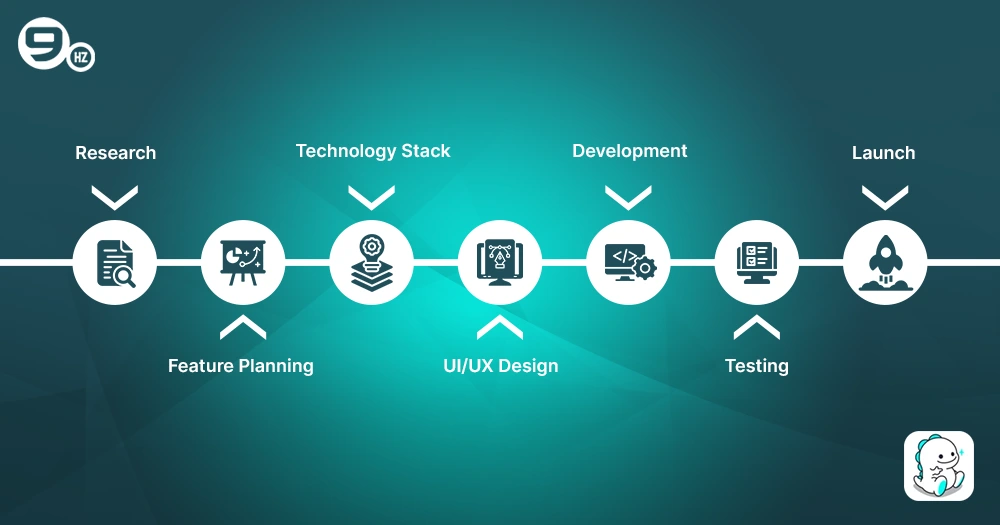
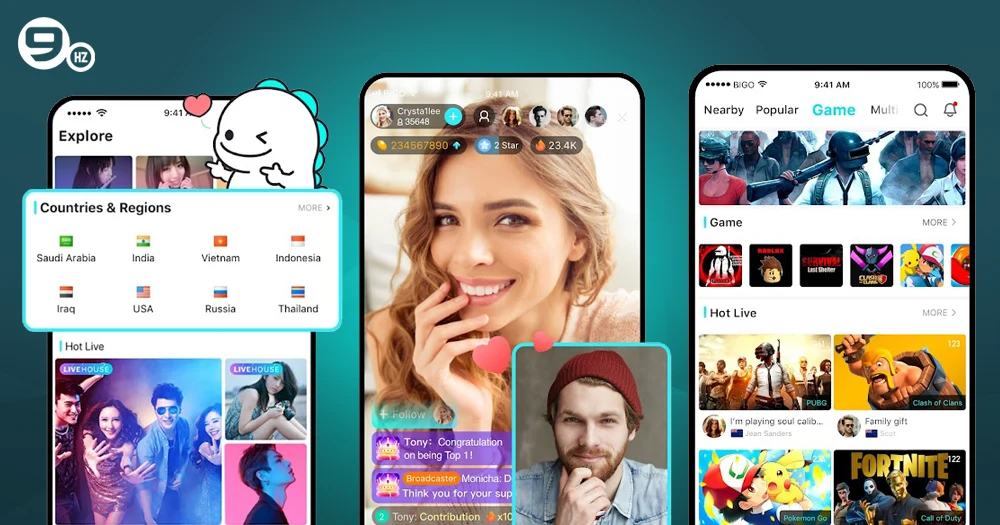
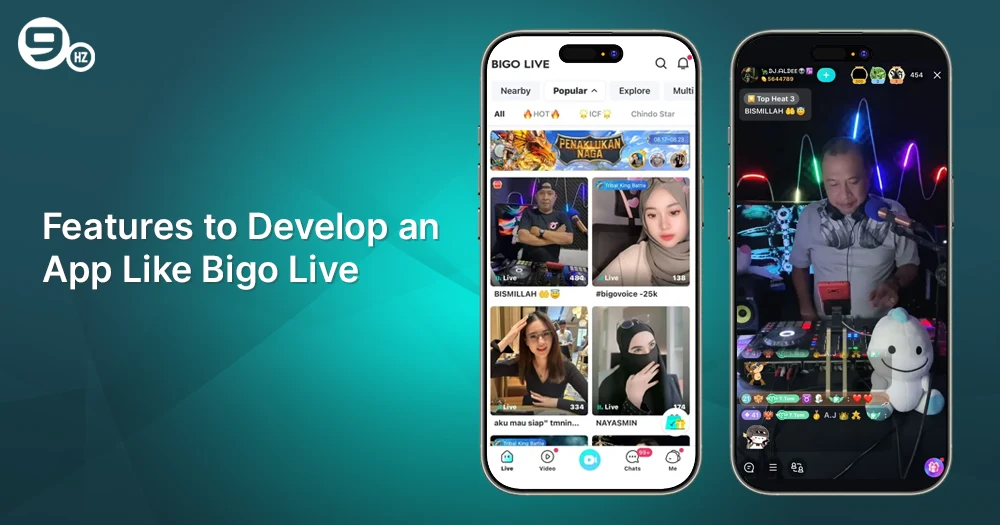
![How to Create an App like Careem? [Cost in 2025]](https://theninehertz.com/wp-content/uploads/2024/09/how-to-create-an-app-like-careem.webp)

![How to Create an AI-Powered Wellness App? [2025 Guide]](https://theninehertz.com/wp-content/uploads/2025/11/how-to-create-an-ai-powered-wellness-app.webp)
